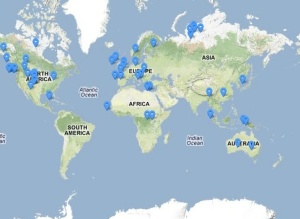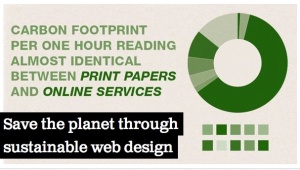Standards of Transparency in Science?
The issue of attention, scrutiny -- and transparency -- has never been more paramount than in science, which sets the gold standard for accountability in the hungry search for truth. But there have always been flaws and biases. (Believe me!) New technologies offer ways to both speed the results publication and expose them to credibility-ranking through criticism, not by abandoning peer review but by finding ways to crowd-source it with feedback ranked by a credibility scoring system. (I have proposed something similar as a terrific business someone might provide for the public as a whole.)
A range of discussions "have pushed publishers to explore alternatives to traditional publishing (such as data journals like GigaScience and data repositories like figshare and Dryad), and to rethink standard business models (for example PeerJ and eLife). (See “Whither Science Publishing,” The Scientist, August 2012.)"
It's an important topic that shows how seriously the smartest people in our civilization are taking on these issues, developing tools of verification and accountability that we can only hope will someday shine light also into the smokey worlds of commerce and politics.
Consider the following as an example of a discovery-trend that pokes hard at standard models and hence merits close scrutiny before acceptance... but which also offers tentative promise of rapid benefits, if confirmed. Hence, rapid 21st Century attention should be applied.
== Solar neutrino dependence for radioactive decay? ==
 Recent research findings appear to suggest the rates of decay of some radioactive elements may vary according to our distance from the sun, or bursts of solar activity. Moreover, one potential practical use may be to detect and predict solar storms well in advance.
Recent research findings appear to suggest the rates of decay of some radioactive elements may vary according to our distance from the sun, or bursts of solar activity. Moreover, one potential practical use may be to detect and predict solar storms well in advance.
The proposed mechanism... some purported effect that solar neutrinos may have on the weak nuclear force... is one that pokes my skeptical reflexes, as a physicist. I am open minded but will need to see a LOT of evidence for something like that.
Here's the basis: Some groups found statistically significant correlations in the rate of decay of certain elements, which appear to be very slightly - but consistently - different in January and July, when the Earth is closest and farthest from the sun, respectively.
"When the Earth is farther away, we have fewer solar neutrinos and the decay rate is a little slower," Jenkins said. "When we are closer, there are more neutrinos, and the decay a little faster." Researchers also have recorded both increases and decreases in decay rates during solar storms.
"Since neutrinos have essentially no mass or charge, the idea that they could be interacting with anything is foreign to physics," Jenkins said. "So, we are saying something that doesn't interact with anything is changing something that can't be changed. Either neutrinos are affecting decay rate or perhaps an unknown particle is."
Fascinating. Let's stay tuned. Above all, let's watch carefully how the newly "tech-speeded" process of discovery, review and publication/feedback works in this test case. The process is very important to us! And let's bring the lessons to the outer world.
==Reinventing Discourse==
 As a matter of fact, I've had a longstanding interest in improving methods of human discourse in general -- which have, unfortunately, not benefited from advances in information technology, anywhere as much as they should. Indeed, judging from the condition of "culture war" in the U.S., discourse is plummeting to incredibly low levels. Yes, search engines allow each of us to glom onto vast amounts of info-stuff on any topic, helping to make us glib and confident in our shallow "facts" (or rather - assertions). But without any processes for analytics, credibility, attribution or accountability, there is just no way for truly bad ideas or memes to die, let alone decline in virulence.
As a matter of fact, I've had a longstanding interest in improving methods of human discourse in general -- which have, unfortunately, not benefited from advances in information technology, anywhere as much as they should. Indeed, judging from the condition of "culture war" in the U.S., discourse is plummeting to incredibly low levels. Yes, search engines allow each of us to glom onto vast amounts of info-stuff on any topic, helping to make us glib and confident in our shallow "facts" (or rather - assertions). But without any processes for analytics, credibility, attribution or accountability, there is just no way for truly bad ideas or memes to die, let alone decline in virulence.
I wrote about this meticulously in Dispute Arenas: Harnessing Conflict and Competitiveness, an article for the American Bar Association's Journal of Dispute Resolution. And I portray in my new novel Existence -- portraying a new future when all the missing parts are in place, allowing free citizens to coalesce upon any problem in "smart mobs" that swiftly self-organize, applying advanced analytic tools and deploying fierce citizenship in rapid-real time. Alas, the horizon does not seem replete with endeavors that might make the dream come true.
See also an accumulation of articles and speculations about transparency, freedom and technology.
So, can we come up with better ways to argue and possibly even negotiate?
 One approach that might be a step in the right direction was pointed-out to me by Dr. Paul Dixon co-founder, Harnu.com. "Harnu is equal parts translation service, news and content aggregation, map interface, and social layer. Our goal is to connect individuals who would otherwise never meet; to allow anyone to send a message or question anywhere in the world, and get an answer back. Our thesis is that if everyone growing up in middle America just knew one person growing up in the Middle East, the world would be a very different place - and that there's no reason that can't happen."
One approach that might be a step in the right direction was pointed-out to me by Dr. Paul Dixon co-founder, Harnu.com. "Harnu is equal parts translation service, news and content aggregation, map interface, and social layer. Our goal is to connect individuals who would otherwise never meet; to allow anyone to send a message or question anywhere in the world, and get an answer back. Our thesis is that if everyone growing up in middle America just knew one person growing up in the Middle East, the world would be a very different place - and that there's no reason that can't happen."
Some of you should try it and report back. A step toward global perspective is welcome.
== Is the e-era green enough? ==
 Pete Markiewicz has posted an interesting article, Save the world through Sustainable Web Design, describing how the "green medium"… publishing and reading electronically… may be a bit less eco-friendly than people think. Oh, the per-word carbon footprint is lower, but the sheer volume has big effects. "According to one estimate, pushing exabytes around in 2011 took as much as ~9% of US electricity (up from 3% in 2000), and 5% worldwide. Processing this energy into bits required enormous amounts of water, mostly for cooling data centers. Within a decade, those same data centers may use more power than the entire airline industry. At the same time, new web services continue to drive the manufacture of new computers, with a resulting mountain of e-waste. Despite steady increases in computing efficiency, the internet’s footprint will only grow larger as populations in Asia and elsewhere come online."
Pete Markiewicz has posted an interesting article, Save the world through Sustainable Web Design, describing how the "green medium"… publishing and reading electronically… may be a bit less eco-friendly than people think. Oh, the per-word carbon footprint is lower, but the sheer volume has big effects. "According to one estimate, pushing exabytes around in 2011 took as much as ~9% of US electricity (up from 3% in 2000), and 5% worldwide. Processing this energy into bits required enormous amounts of water, mostly for cooling data centers. Within a decade, those same data centers may use more power than the entire airline industry. At the same time, new web services continue to drive the manufacture of new computers, with a resulting mountain of e-waste. Despite steady increases in computing efficiency, the internet’s footprint will only grow larger as populations in Asia and elsewhere come online."
== Sci Miscellany ==
* Just when you thought things could not get cooler or weirder... A pulse of light can have almost any shape in space and in time, determined by the amplitudes and phases of its frequency components. Surprisingly, single photons can also be generated in a variety of complex shapes. The difference is that the amplitude for a single photon doesn’t represent a definite value of the electric field strength; instead it’s associated with the probability of detecting the photon at each location and time.
Researchers could also encode information in the photon shape and transmit it from one place to another. There is so much flexibility that a single photon could represent any letter in the alphabet, for example, or even a quantum combination (superposition) of several letters. ... They created photons that had two separate frequency components with a particular phase difference. These photons were efficiently detected using local oscillator pulses that had a matching phase differenc
* See a fun video about how the Gates foundation is offering prizes for the re-invention of the toilet.
Still, along very similar lines, I yearn for a re-invention of our likewise stinky levels of public discourse.



Comments